time-cost tradeoff
One of the analysis that you should perform after evaluating the resource allocation and leveling for your overall project is to evaluate the impact of increasing or decreasing the levels of resources, or their daily productivity. You might be interested in the results of this analysis to decrease key constraining activities such as power outages or to improve productivity of leading production activities such as building structural systems. During a project you may need to make-up for delays experienced elsewhere on the project.
Take a moment and consider the types of actions you, as the project manager, might be able to take to increase the total daily productivity of planned work. Given a standard baseline of productivity what would be the effect of increasing the productivity on the overall cost of the project.
In the Time-Cost Tradeoff analysis you might consider overtime, second shifts, or changing equipment to make some work proceed faster. These additional resources, however, will often increase the cost of the work, above a “standard” work day with the “typical” crew. If all things are equal, there would be no consideration of increasing productivity since any increase in cost of a fixed value project would result in decreased profits. Since indirect costs are not fixed, but are accrued each day on the project, it may be possible to increase the cost of specific activities in order to decrease the time of those activities. Decreasing the duration of those activities may result in an overall decrease in project duration, and hence a decrease on the overhead for job office, home office expenses.
Another reason to consider “buying time” through the Time-Cost? Tradeoff analysis is to avoid liquidated damages penalties that might be imposed for late projects. The expected increase in profit due to early completion bonuses, widely used on urban transportation projects, may also be evaluated through this method.
objective
The objective of the Time-Cost Tradeoff analysis is to determine which activities to “crash” in order to produce the maximum overall job profit. There are two parts to the analysis. First, as the project duration decreases the cost of the project increases. Second, the longer the project continues the higher the overhead costs associated with the project. As demonstrated by the figure below, the Time-Cost Tradeoff helps you to find the sweet-spot between increasing costs of specific activities and decreasing overall project costs.
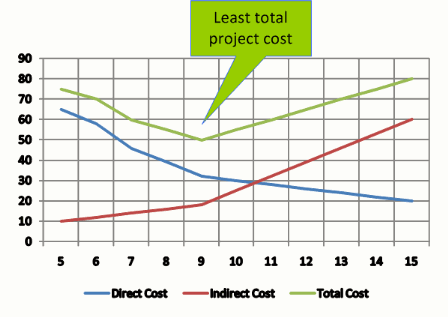
step 1. normal and crash durations
To demonstrate the procedure for Time-Cost Tradeoff we will use the small project, shown below. The four activities in this schedule have a “normal” duration and cost and a “crash” duration and cost. The normal duration reflects the original cost estimate and associated duration for these activities. The crash duration shows the cost of the activity if additional resources, overtime, or other special measures were taken.
| Activity | Prior | Normal | Crash | ||
|---|---|---|---|---|---|
| Duration | Cost | Duration | Cost | ||
| A | none | 3 | $2,000 | 1 | $10,000 |
| B | A | 7 | $4,000 | 3 | $8,000 |
| C | A | 4 | $2,000 | 2 | $10,000 |
| D | C | 5 | $3,000 | 2 | $9,000 |
step 2. cost slope
For this example, let’s assume that there is a linear relationship between the number of days that the activity is accelerated and the increased cost associated with the activity. If we make this assumption, then the cost of crashing each activity can be identified by a line between the normal and crash duration. The slope of the lines, shown below, reflects the cost of crashing each activity an additional day.
For Activity A, the slope of the line between the normal and crashed schedule would be ($10,000 - $2,000) / 1 – 3. The value of the slope is -$4,000/day. The absolute value of the crash slope tells us that we can crash Activity A at the cost of $4,000/day. If we want to crash Activity A one day, then the new cost of Activity A will be the normal cost of the activity, i.e. $2,000, plush one crash day cost, i.e. $4,000, for a total of $6,000.



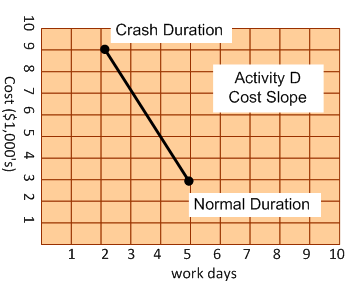
For a quick exercise, print out the table below and determine the cost slope for each activity.
| Activity | Prior | Normal | Crash | Cost Slope | ||
|---|---|---|---|---|---|---|
| Duration | Cost | Duration | Cost | |||
| A | none | 3 | $2,000 | 1 | $10,000 | |
| B | A | 7 | $4,000 | 3 | $8,000 | |
| C | A | 4 | $2,000 | 2 | $10,000 | |
| D | C | 5 | $3,000 | 2 | $9,000 | |
step 3. fenced-bar chart
The first part of this task is to prepare the fenced bar chart. After drawing the fenced bar chart there are two changes: (a) write the cost slope of each activity above the bar; (b) inside the activity bar shade the value of the totally crashed duration. If you do this for the sample project you will see the following diagram.
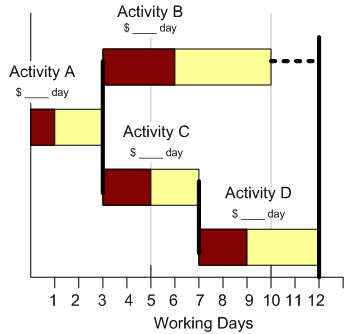
step 4. iterate
Begin crashing activities starting with the least costly and moving to the most costly. The cost to crash the entire schedule will be based upon activities on the critical path. Look at the previous bar chart and consider which activities might be crashed first.
To assist in the analysis you may draw a line through the activities that must be crashed, to reduce the overall project duration. In some cases you must crash more than one activity to decrease the duration of the overall project. The figure below illustrates the result of this process on our fenced bar-chart. Now that you know what may be crashed, let’s determine what specific activities to crash in which order.
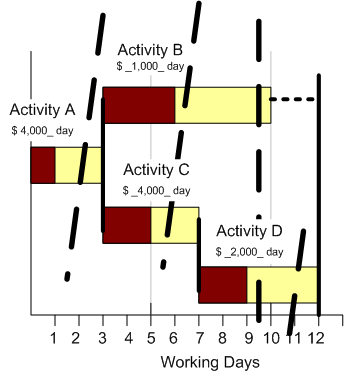
On a scratch paper, list each of the possible crashed activities, noting where multiple activities must be simultaneously crashed. Identify the total cost slope for each set of crashed activities. Sort the activity or set of activities in ascending order.
As you consider which activities to crash be sure to include only those that will decrease the duration of the overall project. Look at the example below. Will spending an extra $1,000 per day to speed up Activity B alone decrease the duration of the project? Clearly not. As you select the activities to crash, be sure that only those individual or combinations of activities that decrease the project duration are selected for crashing.
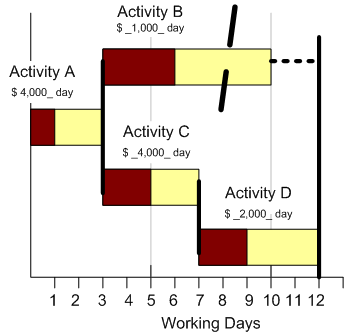
The procedure for crashing the schedule is to begin by selecting the activity or activities with the minimum total cost slope. Crash those activities as much as possible with impacting any other activities. Note the direct cost of that schedule and the duration of the resuling project. Select the next least costly cost slope of activity or activities and continue through the list of activities. For the purposes of clarity, each step in the crash procedure is shown in the diagrams below.
For the example project here are the activities to crash listed in acending order by cost slope.
| Crash Step | Activities to Crash | Crash Duration | Project Duration | Cost Slope |
|---|---|---|---|---|
| 0 | Normal Schedule | 0 | 12 | n/a |
| 1 | Crash D | 2 | 10 | $2,000/day |
| 2 | Crash B & D | 1 | 7 | $3,000/day |
| 3 | Crash A | 2 | 7 | $4,000/day |
| 4 | Crash B & C | 2 | 5 | $5,000/day |
crash 0 - normal schedule

| Activity | Duration | Direct Cost |
|---|---|---|
| A | 3 | $2,000 |
| B | 7 | $4,000 |
| C | 4 | $3,000 |
| D | 5 | $3,000 |
| Total Direct Cost | $11,000 | |
crash 1 - crash D
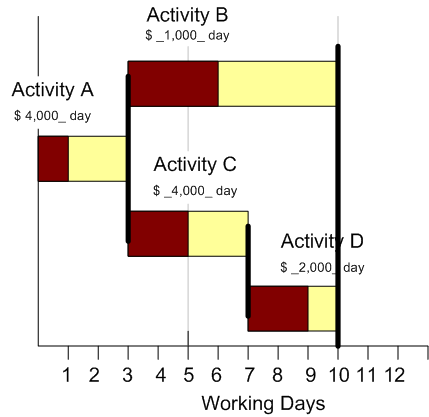
| Crash 1 - Crash D | ||
|---|---|---|
| Activity | Duration | Direct Cost |
| A | 3 | $0,000 |
| B | 7 | $0,000 |
| C | 4 | $0,000 |
| D | 3 | $7,000 |
| Total Direct Cost | $15,000 | |
crash 2 - crash B & D
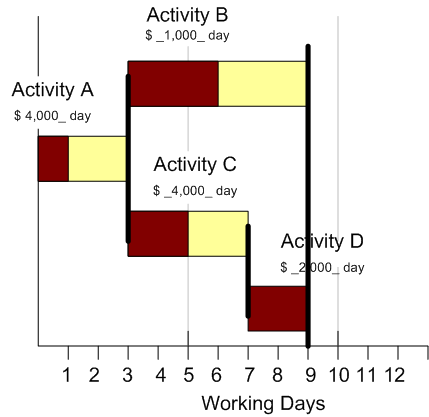
| Crash 2 - Crash B & D | ||
|---|---|---|
| Activity | Duration | Direct Cost |
| A | 3 | $0,000 |
| B | 6 | $5,000 |
| C | 4 | $0,000 |
| D | 2 | $9,000 |
| Total Direct Cost | $18,000 | |
crash 3 - crash A
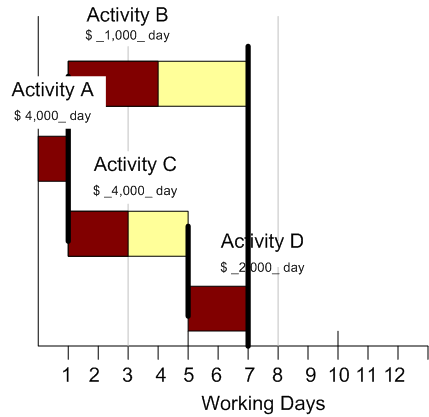
| Crash 2 - Crash A | ||
|---|---|---|
| Activity | Duration | Direct Cost |
| A | 1 | $10,000 |
| B | 6 | $5,000 |
| C | 4 | $0,000 |
| D | 2 | $9,000 |
| Total Direct Cost | $35,000 | |
crash 4 - crash B & C
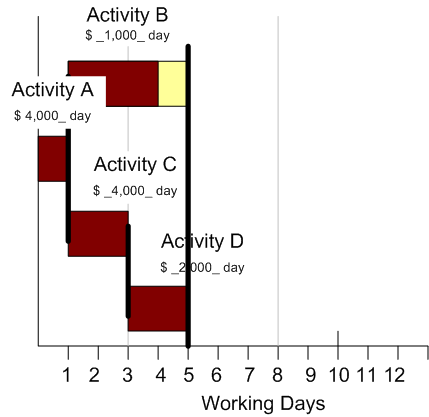
| Crash 4 - Crash B & C | ||
|---|---|---|
| Activity | Duration | Direct Cost |
| A | 1 | $10,000 |
| B | 4 | $6,000 |
| C | 2 | $10,000 |
| D | 2 | $9,000 |
| Total Direct Cost | $37,000 | |
Do you think that we should add another crash step to fully compress the schedule? Why or why not?
step 4. time-cost tradeoff
While there is an increase in direct project costs resulting from crashing the schedule, there is a decrease of indirect costs associated with the project. In addition there may be bonus payments for completing the project early. High indirect costs and incentives make the use of the time-cost trade-off analysis a critical project management tool.
Let’s consider the case where the cost providing the site superintendant, etc… is $1,000/day. Let’s see what the indirect and total project costs will be for each of the crashed schedules.
| Project Duration | Direct Cost | Indirect Cost | Total Cost | Minimum |
|---|---|---|---|---|
| 5 | $35,000 | $5,000 | $40,000 | |
| 7 | $26,000 | $7,000 | $33,000 | |
| 9 | $18,000 | $7,000 | $27,000 | |
| 10 | $15,000 | $10,000 | $25,000 | |
| 12 | $11,000 | $12,000 | $23,000 | <-- |
Here is the time-cost tradeoff chart for the example above.
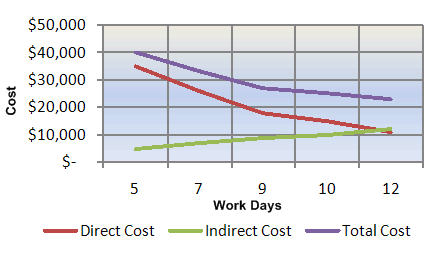
Notice that having low jobsite overhead, a superintendant only, keeps the project from having to be crashed to achieve a minimum cost. If the contractor experiences a delay for which they have to makeup time, i.e. crash some of the activities in the schedule, the contractor has maximum flexibility in crashing low cost activities.
In the next example, let’s consider that the cost of a superintendent trailer and phone is $2,000/day. The owner’s costs are also explicitly included in the contract. In this example, the owner will charge the contractor an additional $3,000/day for each day that the project is late. As with all such penalties, the data after which these penalty charges, or liquidated damages, occur is day eight (8). Let’s re-run the numbers using the table below and see if there are any changes in how we should plan to complete the project.
| Project Duration | Direct Cost | Indirect Cost | Total Cost | Minimum |
|---|---|---|---|---|
| 5 | $35,000 | $10,000 | $45,000 | |
| 7 | $26,000 | $14,000 | $40,000 | |
| 9 | $18,000 | $21,000 | $39,000 | <-- |
| 10 | $15,000 | $26,000 | $41,000 | |
| 12 | $11,000 | $36,000 | $47,000 |
Here is the time-cost tradeoff chart for the example above.

In the situation with higher overhead and incentives (in this case negative incentives, i.e. liquidated damages) The project should be crashed 3 days to achieve the least costsly project. Note that although the project will be completed one day past the owner's required time of 8 days, that the cost to the contract is at it's minimum.